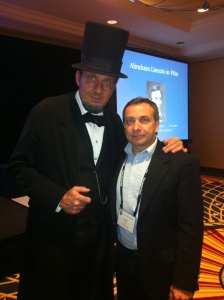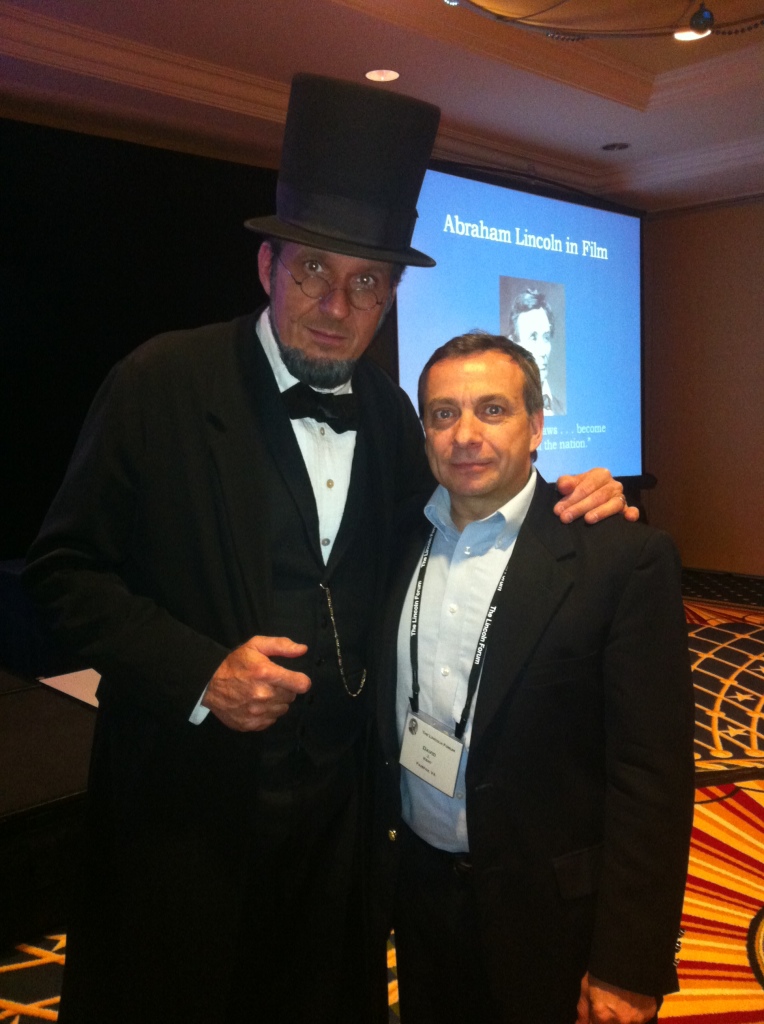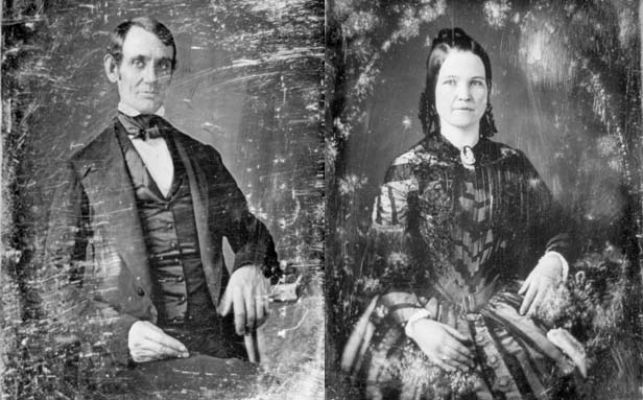 Most people only think of Abraham Lincoln as our 16th President, but prior to that Lincoln had a long career as a lawyer. Much of his legal work was mundane, but he did occasionally get involved in some high profile cases that showed his logic and guile.
Most people only think of Abraham Lincoln as our 16th President, but prior to that Lincoln had a long career as a lawyer. Much of his legal work was mundane, but he did occasionally get involved in some high profile cases that showed his logic and guile.
Author John Evangelist Walsh brings to light one such case in his book Moonlight: Abraham Lincoln and the Almanac Trial. Moonlight is about one of the few murder trials that Abraham Lincoln ever served as defense counsel. Tried in a single day in 1858, just a few months before beginning his campaign for the US Senate in Illinois, Lincoln successfully defended William “Duff” Armstrong on the charge of killing a man in a fight. A co-defendant, James Norris, had been tried separately and had been convicted; he was already serving an eight year sentence. The trial came to be known as the “Almanac” trial because of Lincoln’s adept use of an almanac to demonstrate that the moon was perhaps not so directly overhead as the key witness had suggested. The insinuation, of course, is that the witness could not have been so sure about his description of the incident as he had come across on direct testimony.
Possibly the most interesting thing about the trial was the fact that Lincoln wore a white suit, a far cry from his normal rumpled black suits of fame. There was some rumor that the almanac had somehow been tampered with, a rumor long since shown to be specious. In short, the almanac evidence actually didn’t negate the witness’s testimony, merely created some uncertainty in an otherwise certain insistence of events by the witness. And “reasonable doubt” is all that a defense attorney must elicit from the jury. Lincoln did that and Armstrong, the son of a longtime friend of Lincoln’s, went free.
The book itself is fairly short, and actually not very robust as a work of scholarship. The writing is uneven and the author doesn’t really delve too deeply into events. Overall it seems like Walsh could have put a little more effort into the volume. Still, it gives a lightweight glimpse into a famous trial…a glimpse if not satisfying in its own right, may be just enough to wet the taste for a greater exploration of Lincoln’s casework.
David J. Kent is a lifelong Lincolnophile and is currently working on a book about Abraham Lincoln’s interest in science and technology. He is also the author of Tesla: The Wizard of Electricity and an ebook Nikola Tesla: Renewable Energy Ahead of Its Time.
Follow me by subscribing by email on the home page. And feel free to “Like” my Facebook author’s page and connect on LinkedIn. Share with your friends using the buttons below.



 Abraham Lincoln grew up reading everything he could get his hands on in the largely illiterate western frontier of 19th century America. So it’s no small irony that estimates of books written about Abraham Lincoln run over 15,000 volumes. Some day I’ll count up the number of books about Lincoln I’ve read (I’m guessing over 200) but for now I’ll give you three quick reviews of books related to Lincoln’s own love of books. All of these and more can be found on
Abraham Lincoln grew up reading everything he could get his hands on in the largely illiterate western frontier of 19th century America. So it’s no small irony that estimates of books written about Abraham Lincoln run over 15,000 volumes. Some day I’ll count up the number of books about Lincoln I’ve read (I’m guessing over 200) but for now I’ll give you three quick reviews of books related to Lincoln’s own love of books. All of these and more can be found on  Nikola Tesla had a busy week as Amazon put my e-book
Nikola Tesla had a busy week as Amazon put my e-book  Not to be outdone, Abraham Lincoln was busy as well. First he was in Washington DC for the
Not to be outdone, Abraham Lincoln was busy as well. First he was in Washington DC for the  Thanksgiving also featured prominently in
Thanksgiving also featured prominently in  Finally, as the weather turned colder and the doorstep of winter approaches, The Dake Page took on two topics related to climate denial. The first offered some advice for
Finally, as the weather turned colder and the doorstep of winter approaches, The Dake Page took on two topics related to climate denial. The first offered some advice for  We can thank none other than Abraham Lincoln for the great turkey-eating, pie-gulping, football-watching holiday of Thanksgiving. Yes, Abraham Lincoln.
We can thank none other than Abraham Lincoln for the great turkey-eating, pie-gulping, football-watching holiday of Thanksgiving. Yes, Abraham Lincoln.





 That’s how I start off my most recent piece on Hot White Snow. It all started with a full-day conference on the Election of 1864 sponsored by the Lincoln Group of DC. The next day I flew to Vancouver for SETAC, and then after only a couple of days back took off for Gettysburg and the annual Lincoln Forum.
That’s how I start off my most recent piece on Hot White Snow. It all started with a full-day conference on the Election of 1864 sponsored by the Lincoln Group of DC. The next day I flew to Vancouver for SETAC, and then after only a couple of days back took off for Gettysburg and the annual Lincoln Forum.  Tired of scientists being too technical in describing climate science?
Tired of scientists being too technical in describing climate science? 

 Elizabeth Varon, Professor of History at the University of Virginia, then provided some insights on the election from the South in her talk “Catastrophe or Setback? The Election of 1864 in Confederate Eyes.”
Elizabeth Varon, Professor of History at the University of Virginia, then provided some insights on the election from the South in her talk “Catastrophe or Setback? The Election of 1864 in Confederate Eyes.” “The Summer of ’64” was a critical time period that significantly impacted the election, said University of Kansas Professor Jennifer Weber, author of Copperheads. Grant’s overland campaign had even die-hard Unionists war weary; Weber explored many reasons how military disasters turned into Union – and Lincoln’s – victories.
“The Summer of ’64” was a critical time period that significantly impacted the election, said University of Kansas Professor Jennifer Weber, author of Copperheads. Grant’s overland campaign had even die-hard Unionists war weary; Weber explored many reasons how military disasters turned into Union – and Lincoln’s – victories. Speaking of the military, the soldier vote was crucial to Lincoln’s electoral victory in November. Christopher Newport University Professor and historian Jonathan W. White examined voting dynamics that possibly changed the outcome of the election in “Emancipation and the Soldier Vote of 1864.”
Speaking of the military, the soldier vote was crucial to Lincoln’s electoral victory in November. Christopher Newport University Professor and historian Jonathan W. White examined voting dynamics that possibly changed the outcome of the election in “Emancipation and the Soldier Vote of 1864.” Following these great talks was our keynote speaker, noted historian Michael Burlingame, author and editor of numerous books on Abraham Lincoln. In a wide-ranging talk, Burlingame brought us into the opposition Lincoln faced in reelection, including many in his own party. His “Radicals, Abolitionists, and Lincoln’s Reelection” explored the fickleness not just of the public, but of the lawmakers and generals who worked for and against Lincoln.
Following these great talks was our keynote speaker, noted historian Michael Burlingame, author and editor of numerous books on Abraham Lincoln. In a wide-ranging talk, Burlingame brought us into the opposition Lincoln faced in reelection, including many in his own party. His “Radicals, Abolitionists, and Lincoln’s Reelection” explored the fickleness not just of the public, but of the lawmakers and generals who worked for and against Lincoln.
 What do Picasso’s “Guernica,” David’s “The Death of Marat,” and Wyeth’s “Christina’s World” have in common? They all were posters hanging on my bedroom wall as a teenager. Yes, I was not a normal child. Read more at “
What do Picasso’s “Guernica,” David’s “The Death of Marat,” and Wyeth’s “Christina’s World” have in common? They all were posters hanging on my bedroom wall as a teenager. Yes, I was not a normal child. Read more at “ Two big events in climate science occurred this week. The most important one (IPCC’s Synthesis Report) was largely ignored while the least important one (Mid-Term Elections) will be talked about for the next two years. Check out why on
Two big events in climate science occurred this week. The most important one (IPCC’s Synthesis Report) was largely ignored while the least important one (Mid-Term Elections) will be talked about for the next two years. Check out why on  Speaking of elections,
Speaking of elections,  Meanwhile, this week also saw the anniversary of Lincoln’s tempestuous marriage to Mary Todd. The sudden wedding caught everyone by surprise; could have been because Mary had seduced old Abe? And why did Mary refuse to be photographed with her husband?
Meanwhile, this week also saw the anniversary of Lincoln’s tempestuous marriage to Mary Todd. The sudden wedding caught everyone by surprise; could have been because Mary had seduced old Abe? And why did Mary refuse to be photographed with her husband?  On November 4, 1842, Abraham Lincoln rushed around to his friends and invited them to his one-day’s notice wedding to Mary Todd. The sudden marriage came as a shock to their family and friends, many of whom weren’t aware the couple had resumed their courtship almost two years after the ignominious “fatal first” that ended their prior engagement.
On November 4, 1842, Abraham Lincoln rushed around to his friends and invited them to his one-day’s notice wedding to Mary Todd. The sudden marriage came as a shock to their family and friends, many of whom weren’t aware the couple had resumed their courtship almost two years after the ignominious “fatal first” that ended their prior engagement.


 Abraham Lincoln was reelected for a second term in 1864, which surprised everyone,
Abraham Lincoln was reelected for a second term in 1864, which surprised everyone, 







